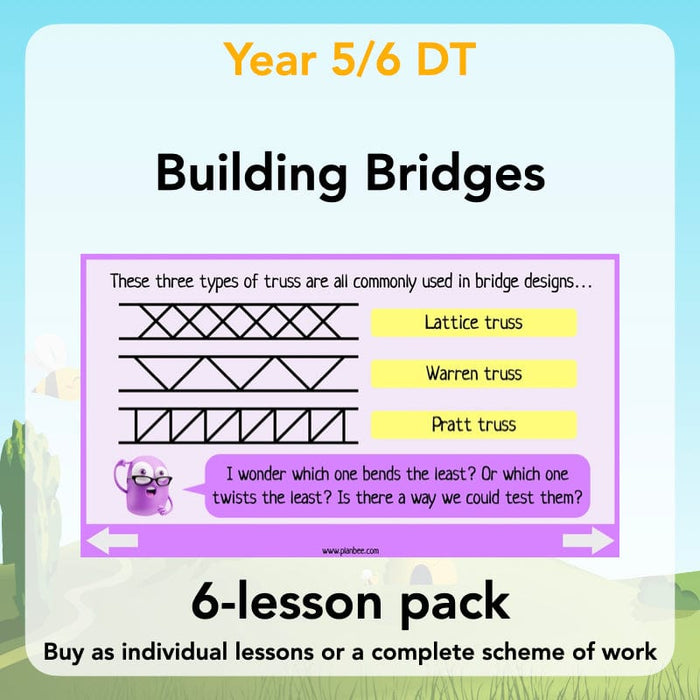

Building Bridges is a six-lesson KS2 Design and Technology scheme of work for Year 5 or Year 6, all about different types of bridges and the structures that support them. It includes lots of practical, differentiated activities, culminating in an exciting prototype/model bridge building challenge.
Using readily-available materials such as card, paper or art straws, children will explore ways in which forces act on bridge structures, how they are constructed and how they are strengthened. Working well as part of a team will be crucial, too – as children get to grips with designing, making and evaluating a variety of bridge designs!
The included slides, planning and printable PDF resources are packed with information about different types of bridges, including diagrams labelling the parts of bridges and the forces acting on them. Every lesson includes a choice of differentiated classroom activities where children will explore how bridges are constructed, and consider ways in which their models may be strengthened, stiffened or reinforced.
Don't forget to download this free Building Bridges display pack.
Beam Bridges
Introduce children to a range of technical vocabulary to describe the features of bridges. Challenge them to consider, then test, how beams and pillars (or piers) are used to span gaps and distribute weight.
Beam Bridges is a ready to teach lesson planning pack for KS2 including slides, worksheets, activities and information all about beam bridges and how they are constructed. It includes beam bridge diagrams and information about bridge piers, too – plus a choice of differentiated tasks where children may construct beams and test their strength.
What's included:
- Lesson plan
- Slides
- Activity ideas
- Differentiated worksheets
- Testing pillars sheet
Truss Bridges
Take a closer look at truss bridges and how they are constructed. This KS2 DT lesson includes slides and printable PDF resources with information about different types of truss bridges and how tension and compression forces act on them. There are practical truss making and testing tasks, too.
Challenge your Year 5 or Year 6 children to consider ways in which forces are changed and distributed along the length of bridges constructed using truss sections, as they experiment with making their own truss bridges using readily-available materials.
What's included:
- Lesson plan
- Slides
- Activity ideas
- Differentiated worksheets
- Truss patterns cards
Arch Bridges
Take a look at arch bridge design and construction with this lesson for Year 5/6. It includes slides, worksheets and practical activities where children will learn about arch bridges, and try building arches themselves.
During this lesson, children will find out about the ways in which materials such as brick or stone distribute compression forces, and how the limitations of these building materials led to the development of intricate and beautiful arch bridge designs. After the slide show presentation and teaching input, they'll go on to test the strength of arches of different shapes and sizes by building models.
What's included:
- Lesson plan
- Slides
- Activity ideas
- Differentiated worksheets
- Challenge card
Suspension Bridges
Take a look at the design of a number of famous and beautiful suspension bridges, then challenge children to build one themselves using everyday materials!
How do suspension bridges work? This Year 5/6 DT lesson is all about suspension bridge design, and the tension and compression forces acting on them. It includes suspension bridge diagrams and practical DT activities, as well as lots of helpful information for teachers and children.
What's included:
- Lesson plan
- Slides
- Activity ideas
- Differentiated worksheets
- Photo cards
- Famous bridges cards
Bridge Building Challenge
Can your Year 5/6 class design and make a bridge out of paper or other materials? In the first part of this two-part lesson, children are challenged to develop a list of design criteria according to a design brief. They are then to design and build a scale-model prototype bridge according to these criteria.
This DT structures lesson planning pack includes slides, detailed information and a range of resources to help children build a strong model bridge out of materials of their choice.
What's included:
- Lesson plan
- Slides
- Activity ideas
- Differentiated worksheets
- Challenge cards
Evaluating Bridge Designs
Test model bridges which children have previously designed and made in this, the second part of a double lesson. The included slides and resources help explain to your children how to devise ways of testing their model bridges according to a list of design criteria. They are then to carry out their tests and draw conclusions based on these, their own views and the views of others.
What's included:
- Lesson plan
- Slides
- Activity ideas
- Differentiated worksheets
- Bridge evaluation sheets
- Bridge builder certificate





































































